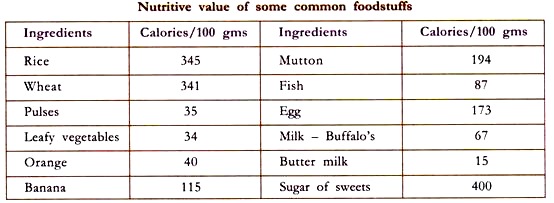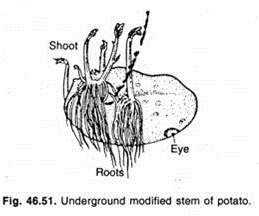ADVERTISEMENTS:
Let us study about Vegetative Reproduction. After reading this article you will learn about: 1. Meaning of Vegetative Reproduction 2. Methods of Vegetative Reproduction 3. Significance.
Meaning of Vegetative Reproduction:
In vegetative propagation, any part of the plant, i.e., stem, root, leaf or even buds are capable to give rise to new plants. The most striking example of such reproductive capacity is seen in the leaves of Bryophyllum. Like other leaves they too carry on photosynthesis, their usual function, but in addition they have the capacity to produce one or more plants from the notches in their margins.
If one keeps a leaf of Bryophyllum on damp soil, within a day or two the buds appear in the notches of the margin of leaf. These buds would later form new plants, complete with roots, leaves and stem.
ADVERTISEMENTS:
More often the capacity for vegetative propagation resides in roots, e.g., in sweet potato, asparagus and dahlia, or stems, e.g., in ginger, turmeric, banana, potato, onion, sugarcane and canna. In all these cases the plant parts possess the power of regeneration, which means that a part of the plant can either replace its lost portion or bring forth a new adult plant.
The capacity for regeneration is quite common in most higher plants and has been put to great use by mankind since time immemorial. Thus, rose, coleus, pothos and glory of garden (Bougainvillaea) are generally propagated by placing their stem cuttings in moist soil. The cuttings soon strike roots and grow into new plants.
Cutting, grafting and layering are generally referred to as artificial methods of vegetative propagation. The resulting offspring are normally identical, and resemble the parent forms in almost all respects. Gardeners generally use these methods for getting plants of same types.
 Methods of Vegetative Reproduction:
Methods of Vegetative Reproduction:
(i) Natural methods and
(ii) Artificial methods.
1. Natural Methods:
In such methods of vegetative propagation, a portion of the plant gets detached from the mother plant and develops into a new independent plant under suitable environmental conditions. The detached parts may be roots, stems, leaves or flowers.
The most striking example of such reproductive capacity is seen in the leaves of Bryophyllum. Like other leaves they too carry on photosynthesis, their usual function, but in addition they have the capacity to produce one or more plants from the notches in their margins.
ADVERTISEMENTS:
If one keeps a leaf of Bryophyllum on damp soil, within a day or two the buds appear in the notches of the margin of leaf. These buds would later form new plants, complete with roots, leaves and stem.
More often the capacity for vegetative propagation resides in roots (e.g., in sweet potato, asparagus and dahlia) or stems (e.g., in ginger, turmeric, banana, potato, onion, zamikand, sugarcane and canna). In all these cases the plant parts possess the power of regeneration, which means that a part of the plant can either replace its lost portion or bring forth a new adult plant.
The stem of plants with sub-aerial modifications, as in Pistia, Chrysanthemum, Eichhornia and pine apple are also used for propagating plants.
In plants, such as Agave, Dioscorea and Oxalis, small buds develop near the flower, leaf axil and tuberous root, respectively, to give rise to new plants. The capacity of regeneration is quite common in most higher plants. In Vallisneria (a submerged water plant), vegetative propagation takes place by means of stolons.
2. Artificial Methods:
ADVERTISEMENTS:
The capacity for regeneration in higher plants has been put to great use by mankind since time immemorial. Thus rose, coleus, pothos, croton, tapioca, China rose and glory of garden (Bougainvillaea) are generally propagated by placing their stem cuttings in moist soil.
The cuttings soon strike roots and grow into new plants. This procedure considerably reduces the time required to obtain a mature plant. In certain other plants, such as lemon, tamarind, etc., the root cuttings are used for vegetative propagation.
As the process of vegetative propagation involves simple cell division, the qualities of the parent plant are faithfully reproduced in the offspring. Some very useful plants like banana and certain varieties of oranges are sterile and do not produce any seeds. Propagation by cuttings is the only method of attaining more of these plants.
Horticulturists have evolved several other methods to produce new plants in a short time.
The methods are as follows:
Layering:
This is one of the most common methods used for propagating plants such as rose, jasmine, grape vine, lemon, rhododendrons and magnolias.
ADVERTISEMENTS:
Layering is the development of roots on a stem while it is still attached to the parent plant. The stem or branch that develops adventitious roots while still attached to the parent plant is called a layer. This is a natural means of reproduction in black raspberries and trailing blackberries. Layering can be artificially induced in many plants.
It can be induced by bending the branch to the ground and covering a medium portion of it below the soil. The apical portion of the branch is left exposed to the air to form the leaves. The part below the soil develops adventitious roots. Now the connection of the layered branch can be cut from the parent plant and grown independently.
Grafting:
This is another method in which man has remarkably exploited the regenerative capacity of higher plants. It is generally practiced in plants which do not root easily or have a weak root system. It is an art of joining parts of two plants of the same or allied species in such a way as to bring about an organic union or fusion of the tissues. This method is practiced in mango, apple, pear, citrus, guava, rose and rubber plant.
It is a common experience that from a mango tree grown a good seed will not always bear fruit of the same quality as the parent tree. Other cultivated fruit trees also show such variations. Under such conditions one may resort to grafting. In this process, a detached part of one plant is inserted into the stem or root system of another plant.
The former is called scion (short piece of detached shoot containing several dormant buds) and the latter stock (longer portion of the plant which is fixed to the soil by its root system). The scion is generally taken from the plant having superior characters.
ADVERTISEMENTS:
In successful grafting, the object is to connect or fit two pieces of living plants in such a way that they will unite and subsequently behave as one plant. This is done in such a way that the cambium tissue of both (scion and stock) comes in contact and forms a cambium layer common to both. Consequently, the two scion and stock grow together.
The place where they are grafted is covered with grafting wax to avoid infection. The scion becomes a part of the plant into which it is grafted. This plant bears flowers and fruits characteristic of the scion. At this junction of graft, union a mass of parenchyma tissue develops from the living cells of both stock and the scion. This tissue heals the wound and is called callus. Its appearance marks successful grafting.
Gootee:
This method is usually employed for vegetative propagation of lemon, orange, guava and litchi during rainy season. In this process, a healthy and woody branch is selected and the bark is sliced off in a ring form of about 3-5 cm in length.
A thick plaster of grafting clay is wrapped up with rag and tied around the debarked portion. The ‘grafting clay’ is prepared by mixing cow-dung, finely cut hay and water. The tied up portion is kept moist by suitable supply of water. In about 2 or 3 months the roots come out and ‘gootee’ is ready to be cut below the tied rag for propagation.
Significance of Vegetative Reproduction:
1. Plants in which useful characters of parents have to be maintained, are propagated vegetatively.
2. The plants which do not produce viable seeds are propagated by this method.
3. Plants with reduced power of sexual reproduction, long dormant period of seed or poor viability are multiplied easily through this method.
4. The plants which are unable to produce seeds as a result of self-pollination cannot breed true. Such plants bear flowers that are only cross-pollinated and thus there is always mixture of characters. Such plants cannot produce seeds that will germinate to give rise to plants exactly like the parent. In such cases, vegetative propagation is the only method to get true to type plants.
5. Vegetative reproduction also helps in removing common infections from the parent plant.
6. Plants raised through vegetative propagation from a single plant constitute a genetically uniform population, the clone. Whereas plants developed from seeds may show variations due to genetic recombination and segregation thus by propagating plants through vegetative means a large stock of selected strains can be built up and maintained without losing the desirable characters.
7. It helps to perpetuate particular form of plants. In some individuals young stage of plants is quite different from the adult form. In order to maintain this young or juvenile form, vegetative propagation is essential.
8. Grafting helps in getting an economically important plant having useful characters of two different individuals in a short time.
9. It is a cheap and rapid method of propagation of the plants with long periods of seed dormancy.













